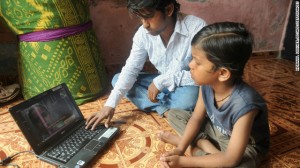A popular topic discussed in class this week was the “Digital Divide” and it immediately made me think about my past trip to India. Fall semester of 2012, I lived in India for over three months and access to technology; especially the Internet was a noticeable challenge. An article published by CNN in December of 2012 titled “How the ‘Silicon Valley of India’ is bridging the digital divide” put the digital divide in India into perspective.
With a population of over 1.2 billion, India Internet penetration across the entire population is below ten percent. Many may find this statistic alarming since India has the world’s second highest number of Facebook users. India is among the worst performing countries in the world for digital inclusion. The digital divide is clear and evident in India, and is specifically noticeable in the areas of wealth, education, occupation and location. This divide is most noticeable in the rural and urban areas of India. Only 20% of urban Indians are connected to the Internet compared to the three percent of rural Indians being connected to the internet, and of the three percent, only eight percent of them are computer literate. The digital divide has become a huge disparity for India, especially those living in rural areas. India has only 22 million Internet subscribers which is less than two percent of the population.
Why aren’t Indians being connected to the Internet?
According to a IAMAI survey 59% of Indians living in rural India who do not have access to the Internet blame the issue on not having internet connection, but 35% blame improper electricity supplies and 39% have no PC at home, There is often no telecoms network infrastructure in Indian villages. Only 0.4 per cent of rural Indians access the Internet from their mobile. 37% of non-users believe they have no need for the Internet and 42% are not aware of the Internet. Another barrier is language. Many people from rural areas do not speak English and there is limited content online in the array of different Indian languages.
Solutions?
Bangalore, the capital of the Indian state of Karnataka is often referred to as India’s Silicon Valley because it’s the city focal point for technology. It has the largest amount of technology entrepreneurs and is home to the worlds most successful software companies. Specific efforts have been made by The Internet Society (ISCOC)’s Bangalore chapter to address this divide. “Using an Internet Society Community Grant of US $9,000, ISOC Bangalore is training everyone from tailors and glass cutters to cotton weavers and furniture makers to download pictures, e-mail, video conference, instant message, use Excel and Word, as well as promote their products on Facebook and Twitter (Canton).” Additional efforts have been made by the Digital Empowerment Foundation in New Delhi, India. This foundation focus is to connect 
January 26th, 2013 at 2:01 pm
I liked this post, but I have to admit that I am skeptical of the scope of the Bangalore plan. Is there a real utility for training them to use services such as twitter when many potential customers lack the ability to access these services from a mobile device? I wonder about the efficiency of some of these skills and hope that time spent teaching them does not come at the expense of more dedicated training with excel and other complex yet powerful software applications.
January 26th, 2013 at 10:18 pm
I just want to hilight how difficult it is for even urban Indians to access the internet. My family lives in Bombay, and only one of my uncles has somewhat reliable internet access. The cost of telecommunications services is fairly high, and internet is even more expensive. Additionally, even when you do have internet access, it is often slow and/or unreliable.
It’s a very interesting situation to look at, especially when you consider how rapidly the technological industry has grown in India in recent years.
January 27th, 2013 at 11:10 am
Neat post. I, also have similar concerns. Do they provide these workers with the devices to utilize these programs in their home settings. $9,000 is quite limited. Who are they even addressing? How are they training residents in remote rural areas?
February 14th, 2013 at 6:29 pm
Interesting post. I wonder if their plan will work to decrease the digital divide in the long term because although the training program may increase digital literacy, because like lack of electricity and internet access are major issues in India.
The statistic “37% of non-users believe they have no need for the Internet” also caught my attention. This is a significant proportion of people and I don’t think that this situation is unique to India; I’m sure that many citizens of developing countries feel the same way… and for very understandable reasons. I wonder how large of a barrier this ‘lack of interest’ factor will play in ICT4D.